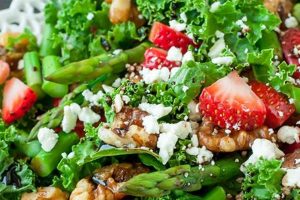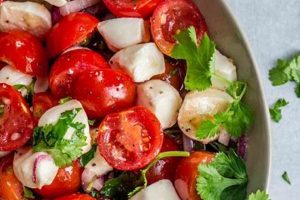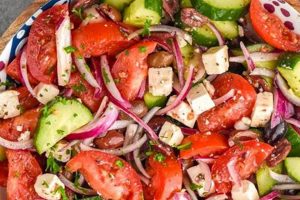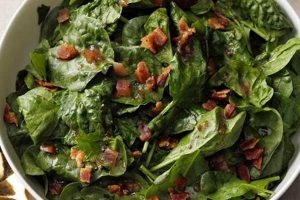This simple, vibrant dish features fresh mozzarella, ripe tomatoes, and fragrant basil, typically arranged on a platter and drizzled with olive oil and balsamic glaze. The addition of sweet cherry tomatoes offers a burst of flavor and visual appeal, complementing the creamy mozzarella and peppery basil. Variations may include different types of mozzarella (such as buffalo mozzarella), balsamic reductions, or additions like olives, pesto, or a sprinkle of sea salt and freshly cracked black pepper.
The appeal lies in the dish’s freshness and the harmonious blend of flavors and textures. Its origins trace back to the island of Capri, Italy, and its colors evoke the Italian flag. The minimal preparation time makes it ideal for a quick appetizer, light lunch, or side dish. Furthermore, its reliance on fresh, high-quality ingredients offers a nutritious and flavorful meal option, rich in vitamins, antioxidants, and healthy fats.
The following sections will delve into specific ingredient selections, step-by-step preparation instructions, variations for different dietary needs and preferences, and tips for achieving optimal presentation and taste.
Tips for a Perfect Caprese Salad
Achieving a truly exceptional salad involves attention to detail and an understanding of the interplay between ingredients. These tips offer guidance for maximizing flavor and presentation.
Tip 1: Ingredient Quality is Paramount: Opt for ripe, in-season tomatoes for the best flavor. Look for vibrant color and a slight give when gently squeezed. Choose fresh, high-quality mozzarella, preferably stored in its brine until just before serving.
Tip 2: Proper Tomato Preparation: Larger tomatoes should be sliced evenly. Cherry tomatoes can be halved or left whole, depending on preference. Salting the tomatoes lightly and allowing them to rest for a few minutes draws out excess moisture and concentrates flavor.
Tip 3: Mozzarella Handling: Slice mozzarella just before assembling the salad to prevent it from drying out. For an elegant presentation, use a sharp knife and aim for uniform slices or pieces.
Tip 4: Basil Selection and Usage: Fresh basil leaves are essential. Avoid bruised or wilted leaves. Tear the basil leaves by hand rather than chopping to preserve their delicate flavor and prevent browning.
Tip 5: Olive Oil and Balsamic Glaze: Use high-quality extra virgin olive oil for its rich flavor and health benefits. A good balsamic glaze should be thick and syrupy, providing a touch of sweetness and acidity. Drizzle both lightly over the assembled salad.
Tip 6: Seasoning and Serving: Season with a pinch of sea salt and freshly cracked black pepper just before serving. For optimal flavor, allow the salad to sit at room temperature for a short time after assembling, allowing the flavors to meld.
Tip 7: Presentation Matters: Arrange the tomato, mozzarella, and basil attractively on a platter or individual plates. Consider adding a garnish of fresh basil sprigs or a drizzle of balsamic reduction for an elegant touch.
By following these guidelines, one can elevate this simple salad to a culinary masterpiece, maximizing the inherent flavors of each component and creating a dish that is both visually appealing and delicious.
The following section will offer variations and adaptations, demonstrating the versatility of this classic dish and providing inspiration for culinary creativity.
1. Fresh, Ripe Cherry Tomatoes
Fresh, ripe cherry tomatoes constitute a crucial element of a successful Caprese salad. Their inherent sweetness and slight acidity contribute significantly to the overall balance of flavors, complementing the creamy mozzarella and peppery basil. The choice of tomato directly impacts the final dish; using subpar, out-of-season, or bland tomatoes can diminish the salad’s vibrancy. For example, a Caprese salad made with mealy, flavorless tomatoes will lack the characteristic burst of freshness that distinguishes the dish. Conversely, using sweet, sun-ripened cherry tomatoes elevates the salad, creating a harmonious blend of flavors and textures.
The size and shape of cherry tomatoes also offer practical advantages. Their compact form allows for easy arrangement and presentation, contributing to the salad’s aesthetic appeal. They can be halved or left whole, offering flexibility in presentation. Furthermore, the high water content of ripe cherry tomatoes contributes to the salad’s refreshing quality, particularly desirable in warmer climates. The structural integrity of a ripe cherry tomato holds up well when combined with the other ingredients, preventing the salad from becoming watery or soggy.
Selecting the appropriate tomatoes is therefore paramount to achieving an authentic and enjoyable Caprese salad experience. Prioritizing ripe, flavorful cherry tomatoes ensures a vibrant, balanced, and refreshing dish. The attention to this seemingly simple ingredient highlights the significant impact ingredient quality has on the final product. Neglecting this aspect can compromise the overall flavor profile and diminish the culinary experience. Choosing wisely ensures the salad remains true to its origins, showcasing the simple elegance of fresh, high-quality ingredients.
2. High-Quality Mozzarella
High-quality mozzarella plays a pivotal role in a Caprese salad, contributing a creamy texture and delicate flavor that balances the acidity of the tomatoes and the peppery notes of basil. The type and quality of mozzarella significantly influence the overall sensory experience. Subpar mozzarella can result in a bland or rubbery texture, detracting from the salad’s freshness and vibrancy. Selecting the right mozzarella is essential for achieving the intended harmony of flavors and textures.
- Freshness and Moisture Content
Fresh mozzarella, ideally stored in its brine, offers a superior taste and texture. The moisture content contributes to the creamy, melt-in-your-mouth sensation characteristic of high-quality mozzarella. Dry or aged mozzarella can result in a less desirable, chewier texture, diminishing the salad’s overall appeal. For instance, fresh buffalo mozzarella, with its higher moisture content, offers a richer, creamier experience compared to pre-packaged, low-moisture mozzarella balls.
- Milk Source and Production Method
The source of milk used in mozzarella production directly affects its flavor profile. Traditional mozzarella di bufala campana, made from water buffalo milk, possesses a distinctive, slightly tangy flavor and rich texture. Cow’s milk mozzarella offers a milder, more readily available alternative. The production method also plays a role; hand-pulled mozzarella typically exhibits a more delicate texture compared to mass-produced varieties. Choosing mozzarella made with high-quality milk and traditional methods ensures a more authentic and flavorful Caprese salad.
- Flavor Profile and Texture
High-quality mozzarella possesses a delicate, milky flavor that complements the other ingredients without overpowering them. Its texture should be smooth and creamy, offering a pleasant contrast to the juicy tomatoes and crisp basil. Avoid mozzarella with overly salty or sour notes, as these can clash with the other flavors. The texture should be neither too firm nor too watery, striking a balance between structure and melt-in-your-mouth creaminess.
- Visual Appeal and Presentation
The visual appeal of mozzarella contributes to the overall presentation of the Caprese salad. High-quality mozzarella, whether sliced or torn, should hold its shape without crumbling excessively. Its pristine white color contrasts beautifully with the red tomatoes and green basil, enhancing the salad’s visual appeal. Uniform slices or artfully torn pieces of mozzarella create a more visually appealing and professional presentation.
The selection of high-quality mozzarella is therefore an integral aspect of creating a truly exceptional Caprese salad. Prioritizing freshness, milk source, flavor profile, and visual appeal ensures a harmonious blend of tastes and textures, elevating this simple dish to a culinary masterpiece. The interplay between the creamy mozzarella, sweet tomatoes, and fragrant basil hinges on the quality of each individual ingredient. By focusing on these details, one can create a Caprese salad that truly honors the simplicity and elegance of Italian cuisine.
3. Fragrant Basil Leaves
Fragrant basil leaves are integral to a Caprese salad, providing a distinctive peppery, slightly minty aroma and flavor that balances the sweetness of ripe tomatoes and the creamy richness of mozzarella. This aromatic herb elevates the salad beyond a simple combination of ingredients, adding complexity and depth. The absence of basil diminishes the sensory experience, resulting in a less vibrant and balanced flavor profile. For example, a Caprese salad made without basil might taste overly sweet or lack the characteristic herbal counterpoint that defines the dish.
The variety of basil used can further influence the overall flavor profile. Sweet basil, the most common variety, offers a classic peppery-sweet flavor that harmonizes well with the other ingredients. Other varieties, such as Genovese basil or Thai basil, introduce subtle nuances, offering opportunities for flavor exploration. The freshness of the basil is paramount. Wilted or bruised leaves lack the vibrant aroma and flavor essential for a successful Caprese salad. Freshly picked leaves offer the most potent aroma and flavor, enhancing the overall sensory experience. Furthermore, the method of preparation impacts the basil’s contribution to the salad. Tearing the leaves by hand, rather than chopping them, preserves their delicate structure and essential oils, maximizing their aromatic and flavor contribution.
The strategic placement of basil within the salad also affects the sensory experience. Distributing the leaves evenly throughout the salad ensures a consistent flavor profile in each bite. Placing some leaves whole atop the salad adds visual appeal and provides bursts of intense flavor. The interplay between the basil, tomatoes, and mozzarella creates a synergistic effect, where the individual flavors enhance one another. Understanding the role of fragrant basil leaves in a Caprese salad allows for a more nuanced appreciation of this classic dish. It highlights the importance of ingredient quality, preparation methods, and strategic placement in achieving a balanced and flavorful culinary experience. The seemingly simple addition of basil transforms the salad, demonstrating the significant impact even a single ingredient can have on the final product.
4. Extra Virgin Olive Oil
Extra virgin olive oil is not merely a condiment in a Caprese salad with cherry tomatoes; it is a vital component that elevates the dish and unifies its flavors. Its presence contributes richness, aroma, and a textural element that enhances the overall sensory experience. The specific characteristics of extra virgin olive oil, namely its low acidity, fruity notes, and peppery finish, interact synergistically with the other ingredients. The oil’s fruity notes complement the sweetness of the tomatoes, while its peppery finish provides a subtle counterpoint to the creamy mozzarella and fragrant basil. Furthermore, the oil acts as a binding agent, coating the ingredients and allowing the flavors to meld together harmoniously. For instance, a Caprese salad dressed with a robust, peppery extra virgin olive oil from Tuscany offers a different flavor profile compared to one dressed with a milder, fruitier oil from Liguria. This demonstrates the significant impact the choice of olive oil has on the final dish.
The quality of the extra virgin olive oil significantly influences the salad’s overall flavor profile. A high-quality extra virgin olive oil, characterized by its low acidity and fresh, fruity aroma, enhances the inherent flavors of the tomatoes, mozzarella, and basil. Conversely, a lower-quality oil can introduce undesirable flavors and detract from the salad’s freshness. The oil’s viscosity also plays a role; a thicker oil coats the ingredients more effectively, distributing flavor and contributing to a more luxurious mouthfeel. Consider the difference between a Caprese salad dressed with a light, delicate extra virgin olive oil and one dressed with a thicker, more viscous oil. The latter offers a richer, more substantial coating, enhancing the overall textural experience. This illustrates the importance of selecting an extra virgin olive oil that complements the other ingredients and contributes to the desired sensory outcome.
Understanding the role of extra virgin olive oil in a Caprese salad with cherry tomatoes allows for a more informed approach to ingredient selection and preparation. It highlights the importance of quality, flavor profile, and viscosity in achieving a balanced and harmonious dish. Choosing the right extra virgin olive oil is not simply a matter of preference, but a crucial step in maximizing the salad’s potential. This knowledge empowers culinary enthusiasts to create a Caprese salad that transcends its simple components and becomes a true culinary expression. The seemingly simple act of drizzling olive oil over the salad becomes a deliberate and meaningful step in crafting a dish that celebrates the interplay of fresh, high-quality ingredients. The impact extends beyond mere flavor enhancement; it embodies a deeper understanding of the culinary arts and the transformative power of carefully chosen ingredients.
5. Balsamic Glaze
Balsamic glaze contributes a crucial layer of complexity to a Caprese salad with cherry tomatoes, moving beyond simple sweetness and adding depth through its tangy, slightly sweet, and viscous character. This glaze, a reduction of balsamic vinegar, provides a concentrated flavor profile that complements the other core ingredients. The inherent sweetness of ripe cherry tomatoes and creamy mozzarella finds balance in the balsamic glaze’s acidity, preventing the salad from tasting overly sweet or one-dimensional. Furthermore, the glaze’s viscosity adds a textural element, clinging to the ingredients and ensuring an even distribution of flavor. Consider the contrast between a Caprese salad finished with a simple drizzle of olive oil and one enhanced with balsamic glaze. The latter offers a more complex interplay of sweet, tangy, and savory notes, demonstrating the glaze’s integral role in elevating the dish.
The quality and type of balsamic glaze influence the final flavor profile. A high-quality glaze, typically made with concentrated grape must, possesses a rich, complex sweetness and a smooth, syrupy consistency. Lower-quality glazes might contain added sugars or thickeners, resulting in a less nuanced flavor and texture. The method of application also affects the sensory experience. A light drizzle creates pockets of intense flavor, while a more generous application provides a consistent tang throughout each bite. For instance, a Caprese salad featuring a high-quality, aged balsamic glaze offers a more pronounced depth of flavor compared to one using a commercially produced glaze with added sugars. This distinction highlights the importance of selecting a glaze that complements the other ingredients and contributes to the desired flavor profile. Furthermore, the glaze’s visual appeal enhances the salad’s presentation. Its dark, glossy appearance provides an elegant contrast to the vibrant colors of the tomatoes, mozzarella, and basil. The way the glaze drapes over the ingredients adds a touch of visual sophistication, transforming a simple salad into a visually appealing culinary creation.
Integrating balsamic glaze into a Caprese salad with cherry tomatoes demonstrates an understanding of flavor balance, texture, and visual presentation. The glaze’s role extends beyond mere sweetness, adding depth and complexity to the dish. Challenges in utilizing balsamic glaze might include selecting a high-quality product and achieving the appropriate balance of flavors. However, careful selection and application transform this simple salad into a more refined and flavorful experience, highlighting the significant impact of seemingly minor additions. Understanding the glaze’s contribution to the overall composition empowers culinary enthusiasts to create a Caprese salad that transcends its basic components, showcasing a nuanced appreciation for flavor and presentation.
6. Simple Preparation
The ease of preparation is a defining characteristic of the Caprese salad with cherry tomatoes. This simplicity underscores the emphasis on fresh, high-quality ingredients, allowing their inherent flavors to shine through without complex culinary manipulations. Minimal processing preserves the integrity of each component, resulting in a dish that celebrates the natural synergy between ripe tomatoes, creamy mozzarella, fragrant basil, and good olive oil. Consider the contrast between a labor-intensive dish requiring hours of preparation and a Caprese salad, assembled in minutes. The latters simplicity allows the focus to remain on the quality of the ingredients rather than complex techniques, highlighting the inherent elegance of fresh, seasonal produce. For example, preparing a Caprese salad involves simply slicing tomatoes and mozzarella, tearing basil leaves, and drizzling with olive oil and balsamic glaze. This minimal intervention preserves the ingredients’ natural flavors and textures, a key element of the dish’s appeal.
The straightforward preparation also contributes to the Caprese salad’s versatility. Its adaptability to various occasions, from a quick lunch to an elegant appetizer, stems from the minimal time and effort required. This ease of assembly makes it an ideal choice for impromptu gatherings or situations where elaborate cooking is impractical. Furthermore, the simplicity of the recipe encourages culinary experimentation. Variations incorporating different types of tomatoes, mozzarella, or basil, or additions like olives or pesto, can be easily implemented without compromising the dish’s fundamental character. This adaptability makes the Caprese salad a canvas for culinary creativity, allowing individuals to personalize the dish while retaining its core essence. The inherent simplicity also translates to easy cleanup, further enhancing its practicality.
The connection between simple preparation and the Caprese salad with cherry tomatoes is fundamental to the dish’s enduring appeal. It reflects a culinary philosophy that prioritizes fresh, high-quality ingredients and minimal intervention. This approach allows the natural flavors of the components to shine through, resulting in a dish that is both elegant and accessible. While challenges might include sourcing high-quality ingredients, the minimal preparation involved ensures that the focus remains on the quality of the components, ultimately resulting in a dish that celebrates the inherent simplicity and flavor of fresh, seasonal produce. This understanding emphasizes the significant impact of ingredient selection and underscores the Caprese salads position as a testament to the beauty of uncomplicated, fresh cuisine.
7. Elegant Presentation
Elegant presentation elevates the Caprese salad with cherry tomatoes from a simple dish to a visually appealing culinary experience. While the quality of ingredients remains paramount, thoughtful presentation enhances the sensory experience, transforming the salad into a feast for the eyes as well as the palate. This visual appeal stems from the inherent contrast in colors and textures: the vibrant red of ripe cherry tomatoes, the pristine white of fresh mozzarella, the deep green of basil leaves, and the glistening sheen of olive oil and balsamic glaze. A haphazard arrangement diminishes this inherent beauty, while a considered presentation amplifies the salad’s visual impact. For instance, arranging the sliced tomatoes, mozzarella, and basil in an alternating, overlapping pattern on a platter creates a visually dynamic composition that enhances the dining experience. A simple garnish, such as a swirl of balsamic reduction or a scattering of microgreens, further elevates the presentation.
The practical significance of elegant presentation extends beyond mere aesthetics. It communicates care and attention to detail, enhancing the perceived value of the dish. In a restaurant setting, a beautifully presented Caprese salad signals culinary expertise and elevates the dining experience. Even in a home setting, thoughtful plating transforms a simple weeknight meal into a special occasion. Consider the difference between serving the salad directly from a mixing bowl versus arranging it artfully on individual plates. The latter demonstrates an intentionality that elevates the dining experience, transforming a simple act of eating into a more mindful and aesthetically pleasing activity. Furthermore, elegant presentation can stimulate appetite and enhance enjoyment. A visually appealing dish engages the senses, creating anticipation and enhancing the overall culinary experience.
Achieving elegant presentation requires minimal effort but significant impact. Challenges might include limited time or resources, but simple techniques, such as using a sharp knife for clean cuts, selecting attractive servingware, and considering the interplay of colors and textures, can significantly enhance the visual appeal of the Caprese salad. The key lies in understanding the inherent beauty of the ingredients and showcasing them in a way that maximizes their visual impact. This attention to presentation underscores a respect for the ingredients and elevates the Caprese salad from a simple combination of components to a visually stunning and memorable culinary experience. Ultimately, elegant presentation enhances not only the perception of the dish but also the enjoyment of the dining experience itself, demonstrating the powerful connection between visual appeal and culinary appreciation.
Frequently Asked Questions
This section addresses common inquiries regarding the preparation and enjoyment of Caprese salad with cherry tomatoes, offering clarity and practical guidance.
Question 1: Can other types of tomatoes be used in a Caprese salad?
While cherry tomatoes are ideal due to their sweetness and size, larger tomatoes such as heirloom or beefsteak varieties can be used. Ensure they are ripe and flavorful. Slice them into even pieces comparable in size to the mozzarella.
Question 2: What is the best way to store fresh mozzarella?
Store fresh mozzarella in its original brine in the refrigerator. This helps maintain its moisture content and optimal texture. Avoid freezing mozzarella, as this compromises its texture.
Question 3: Can the salad be prepared in advance?
While best assembled just before serving, the components can be prepared separately in advance. Store sliced tomatoes, mozzarella, and basil leaves in airtight containers in the refrigerator. Combine and dress just before serving to maintain optimal freshness and prevent the salad from becoming watery.
Question 4: What are some suitable alternatives to balsamic glaze?
A reduction of balsamic vinegar offers a similar flavor profile. A light drizzle of high-quality red wine vinegar can also provide a complementary acidity. A pesto drizzle can be added.
Question 5: How can one adapt the recipe for vegan diets?
Vegan mozzarella alternatives, made from cashew nuts or other plant-based ingredients, can be substituted for traditional mozzarella. Ensure the chosen alternative offers a comparable texture and flavor profile.
Question 6: How long can a prepared Caprese salad be stored?
Consume the salad within two hours of preparation for optimal flavor and food safety, especially during warmer months. Refrigerate any leftovers promptly in an airtight container. However, the texture and appearance may change upon refrigeration.
Understanding these key aspects of preparation and storage ensures a consistently enjoyable Caprese salad experience. Attention to detail, even in seemingly simple matters, maximizes flavor and preserves freshness.
The next section will offer a curated selection of variations on the classic Caprese salad, showcasing the dish’s versatility and adaptability.
Conclusion
This exploration of the Caprese salad with cherry tomatoes has highlighted the essential elements that contribute to its enduring appeal: the quality of ingredients, the simplicity of preparation, and the elegance of presentation. From the selection of ripe, flavorful tomatoes and fresh, creamy mozzarella to the fragrant basil, extra virgin olive oil, and tangy balsamic glaze, each component plays a crucial role in the final composition. The ease of assembly makes this dish accessible to culinary enthusiasts of all levels, while the potential for creative variations allows for personalized interpretations.
The Caprese salad embodies a culinary philosophy that values simplicity, freshness, and the inherent beauty of quality ingredients. Its enduring popularity speaks to the timeless appeal of dishes that celebrate the natural flavors of seasonal produce. Further exploration of regional variations and ingredient pairings offers continued opportunities for culinary discovery and an ever-deepening appreciation for this classic Italian salad.






